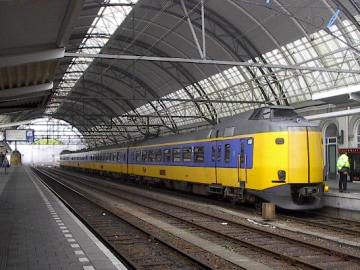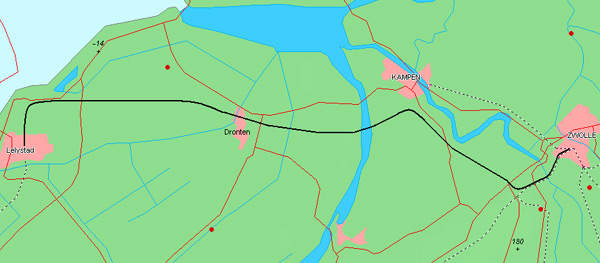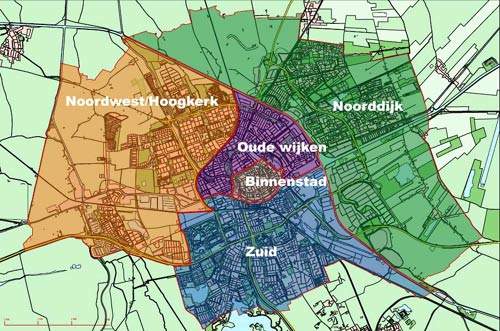The 50km Hanze Line (Hanzelijn) runs between Lelystad and Zwolle in the Netherlands to ease commuter congestion on the roads between Amsterdam and the provinces of Groningen and Friesland.
Passenger services on the new line were inaugurated in December 2012. With the much-awaited service, the Amsterdam-Zwolle travelling time is expected to be cut by 15 minutes and the Lelystad-Zwolle journey time will take 30 minutes.
The project
Work was started following the construction contract on 20 February 2008 between the Netherlands government and ProRail, the state-owned organisation responsible for the Netherlands’ national rail infrastructure.
Under the contract, ProRail took up construction, maintenance, capacity management and traffic control.
The Hanze route starts from the existing terminus at Lelystad, and was extended with two more tracks and an island platform. In Flevoland province, the railway line runs between Lelystad and Dronten alongside the new N23 road. A new station accommodating around 2,800 passengers per day was built at the town of Kampen.
In 1997-2003 Arcadis received a contract from ProRail to work on the Hanze route’s alignment study, designing of immersed tube tunnels, evaluation of alternatives and environmental assessment.
In the 1996-2005 year plan, however, the previous contract was modified for planning and environmental impact assessment of the rail link between Lelystad and Zwolle.
The final urban planning for Hanjelijn stations was drafted in 2002 with Prorail awarding Arcadis the contract to plan and integrate Dronten, Kampen and Lelystad stations.
On 12 May 2009, a contract worth €164m for the superstructure of the Hanze Line was signed between Prorail and the HanzaRail consortium. Under the contract, the HanzaRail team was responsible for track, signalling, baffle boards, ballast, catenary and rail dampers. The company also constructed 133,000 sleepers, 400km of overhead wiring, 13,000 rails, 1,500 masts and 22km of baffle boards.
While consortium partner Alstom installed the signalling system, other partners Arcadis, Strukton Rail and VolkerRail worked on design and construction of the tracks.
Infrastructure
Lelystad station was modified and doubled in size by adding four platforms. It can handle around 14,000 passengers a day. The track has been designed to take a turn to the north part of the town to reach an isolated green field side.
According to the decision of the Flevoland province, the N23 road planned between Lelystad and Dronten runs along with the same corridors that the Hanze line connects. The track is laid on embankments and viaducts through Dronten, where nearly 3,000 passengers are expected to use a four-track station.
In an effort to make the transport system more convenient, the Hanze line has a dual-signalling system. In addition, the route is not intersected anywhere by level crossings.
Passengers witness less traffic between major stations like Amsterdam, Hilversum and Amersfoort, because of the modernising of routes and frequency of services. The route also gained a new bridge between IJssel and Hattem and a 750m tunnel under the Drontermeer between Kampen and Dronten.
Rolling stock
The Hanze Rail tracks are designed to withstand a speed of 200km/hr. However, in the Netherlands there is no domestic rolling stock with a capacity faster than 160km/hr.
To solve this, Netherlands Railways/ Nederlandse Spoorwegen (NS) is purchasing 50 more class Verlengd InterRegio Materiaal (VIRM) double-deck electric multiple units from Canadian rail transportation company Bombardier.
Signalling and communications
Alstom installed its signalling system, Atlas control and Automatische Trein Beinvloeding (ATB) system on the track with European Rail Traffic Management System (ERTMS) Level 2 standards. A contract worth €27m was awarded to Alstom for this. The company has also received a 15-year maintenance contract for the complete signalling system.
The agreement covers track, 1.5kV DC electrification and sound mitigation measures. The consortium will initiate installation work by early 2010. While completion is planned for the end of 2012, services are to start in 2013.
The ERTMS includes a European Train Control System. This system contains Global System for Mobile Communications-Railway (GSM-R) technology, the digital radio-transmission standard for railways, and train-borne equipment, ensuring safe operation of trains.
ERTMS is designed for progressive implementation on railway lines; each level offers progressive increase in traffic optimisation. While Level 1 provides automatic train protection (ATP), which controls the train speed, Level 2 provides ATP plus movement authority via radio (GSM-R). Level 3 allows moving-block operation.
The future
As the government announced its plans to scrap the €10bn Zuiderzee Line between Amsterdam and Groningen, passenger dependence on the Hanze Rail has increased.
To improve services from Amsterdam to Almere and in Groningen, it has been suggested to build a rail cut-off parallel to the A1 motorway using the €2.7bn fund additionally earmarked for Zuiderzee Line.
Proposals also suggest a viaduct to take the railway line over the A28 motorway junction. This line will continue to run on embankments to reach a junction with the main line from Amersfoorts.
NS is planning to accommodate as many as 30 daily freight trains in each direction. It is also considering running two intercity and two stopping trains in each direction per hour on the Hanze Line, which the Ministry of Transport, Public Works & Water Management expects will carry 32,000 passengers a day.










